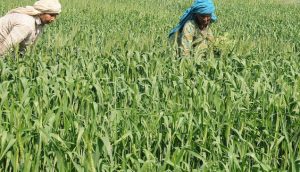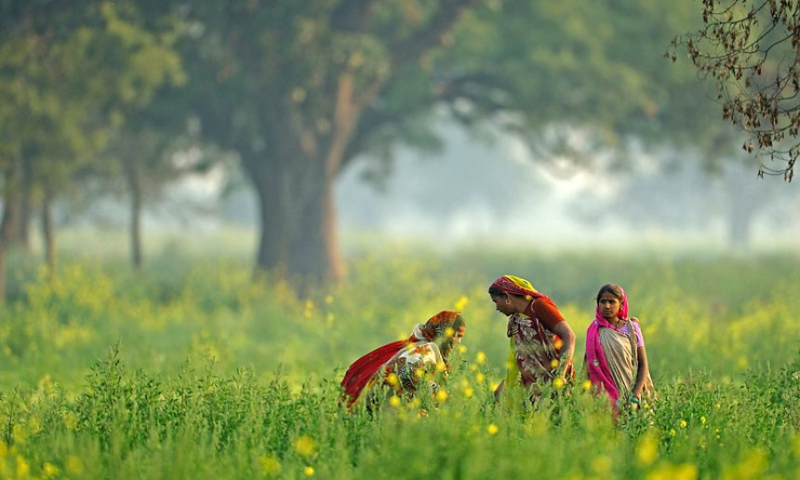Government must assess impact of Demonetization on Agriculture at the earliest to arrest Production and Earnings loss

Strategic changes happening in Seeds and Agrochemical companies to control Agriculture
November 19, 2016
Rice farming in Indian Subcontinent older than China; Also Indus People earliest to use Multi Cropping
December 5, 2016Nirmesh Singh, Shakti Sharan Singh & Arun Pandey
Fifty days of demonetization have coincided with fifty days of Rabi crop sowing season. Demonetization should not have been so ill timed for agriculture. Considering the fact that nearly 55% of Indians are employed in agriculture and village economy is vastly cash based, demonetization of Rs 500 and Rs 1000 notes doomed the sowing activity, selling of already harvested crops, loss of wages to farmers and farm labourers and the ongoing marriage season.
Farmers’ Protests
In the district of Una in Himachal Pradesh, potato cultivators have been hit hard. Both the sales and prices of potato have dipped. Merchants who come to buy potato harvest are not there. Therefore, the potato crop that is harvested in second week of November is still standing in the fields.

Hope Wheat Crop does not suffer
Wheat sowing in Punjab and Haryana is also bad affected. Farmers do not have money to buys seeds, fertilizers and diesel. According to sources, 75% and 70% of wheat sowing in Punjab and Haryana, respectively has already been completed. But according to agriculture experts sowing should have been ideally completed by mid November. Delays may result in loss of 1.5 quintals per acre every week. However, the central government in their press release last week had claimed that sown area of wheat till 18th November 2016 was 79.40 lakh hectares as compared to 78.83 lakh hectares last year.
In Maharashtra too, sowing of gram and wheat have been hit. The state agriculture department official told that farmers don’t have new currency cash so they are facing difficulties in buying seeds and fertilizers; consequently, the sowing area of Rabi crop has dropped. In Maharashtra, the Rabi sown area till November this year is less than that of last year due to a combination of late kharif harvesting and the recent demonetization issue.

Farmers in Gujarat are also protesting. They dumped grain and milk on the streets in massive rallies in Surat and Anand last week. In Surat, thousands of farmers from Gujarat Khedut Samaj (GKS) drove in 150 tractors and over 100 trucks loaded with grain and sugarcane and covered the 10-km stretch from Jehangirpura to the Collector’s office . Speaking to Agri Nation, President of Dakshin Gujarat Khedut Samaj, Jayesh Patel told that demonetization had hit the farmers badly. He also told that the situation might become worse for farmers as most of them had accounts with district co-operative banks which are not accepting defunct currency notes.
In addition to this there are reports of protests from farmers against demonetization at many other places across India.
Centre announces Relief
Seeing the farmers protesting all over India against demonetization, Prime Minister has tried to keep providing relief accordingly in steps. First it reset a new limit for withdrawal of cash for farmers so that farmers could draw up to Rs 25,000 per week against crop loans sanctioned and credited to their accounts subjected to loan limits. The Kisan Credit Cards would be the subject of the same limitations. The government has also extended the time limit on the crop insurance premium by 15 days. For APMC traders it allowed them to draw Rs 50,000 per week.
Now, Centre has also added more relief for cash-strapped farmers by permitting them to use old Rs 500 notes for purchasing seeds from any state or central government outlets and agri universities on production of proof of identity. When Agri Nation spoke to Bhagwat Singh, a farmer in Moodi Bakapur Village, he told that majority of farmers procure seeds from local shopkeepers of Aurangabad (nearest kasba/town) selling agri related seeds, fertilizers and pesticides. Govt must extend the use of old currency at these shops too till Rabi sowing is over.
Today, Government has announced that National Bank for Agriculture and Rural Development (NABARD) will disburse 210 billion rupees ($3.07 billion) to farmers to help them sow winter crops such as wheat. Shaktikanta Das, economic affairs secretary, said that NABARD would disburse the money through farm cooperatives. This decision is expected to give some relief to farmers who are facing financial difficulties due to demonetization and help them to buy seeds and fertilisers for winter crops. The move of unexpected demonetization is threatening production of key commodities and hurting rural communities that were only just recovering after two years of drought. Under the scheme, small farmers will get 40 percent of their credit from cooperative banks. But question arises, that farmers in the country are already reeling under heavy debts and low income that has resulted in suicides. How much helpful it will be , is something that needs to be seen.
Banking – a major problem and challenge in rural India to tackle demonetization
Banking in rural India is the major problem and challenge. There is already a shortage of cash in banks in both cities and rural areas. Question arises – will the banks be able to give cash to farmers? Village economy is mostly and vastly cash based. There is only one bank branch for 13 villages. The average number of employees in one rural branch is just three. As per census 2011, 70 % of India’s population lives in rural India. As per 2011 census, the total number of villages in India is 6, 40,867 while the number of bank branches in rural India is only 50,451. Due to this we can see the videos of chaos in the banks in rural areas, viral on social media.
Impact of Demonetization
According to Renu Kohli, an economist, “Production in 2016-17 could drop if sowed acreage (Rabi) reduces for want of enough seeds on time to exploit the adequate soil moisture. Yields could fall from late sowing and subsequent exposure to rough spring weather, the lack of sufficient or timely application of fertilizers, pesticides, etc. Farm labour, vital for this period, is reported to be unpaid as farmers have no cash. Many of them are reported to be returning from some northern parts to homes in UP and Bihar. Labour shortages and wage-spikes may follow with a lag. Plantation crops such as rubber, tea, jute, cardamom are seeing no wages paid to workers. Small-medium tea growers have few buyers now (a third of the tea was unsold in recent auction in the south). Raw jute trade is halted as paucity of funds affects procurement-delivery by traders. Projections of scarcity have appeared with appeals for official procurement support. Cotton is witnessing havoc: daily arrivals have plunged to 30,000-40,000 bales against the usual 1.5-2 lakh bales at this time (harvest) as per reports and prices have soared 9% in a week, pushing up global prices in turn”. She has also said that vegetables and fruits along with crops (added 61% of agriculture’s gross value added in 2015-16), depends critically upon a cash-strapped transport sector for daily supply network. Sales have dropped sharply (25-50%) across markets with occurrences of dumping. At present, demand is repressed for want of currency, so prices are subdued, but eventually, supply shortages could cause prices to rise.
How much loss will agriculture accrue finally? How much will demonetization hit the 55% Indians employed in the sector? Worst fact is the average monthly income of farmers in India, that is, Rs 3000 per month. More effects of demonetization on agriculture and farmers will surface in next 2-3 months. Union Government must assess it at the earliest to arrest the production and earnings loss.
——————————————————–


